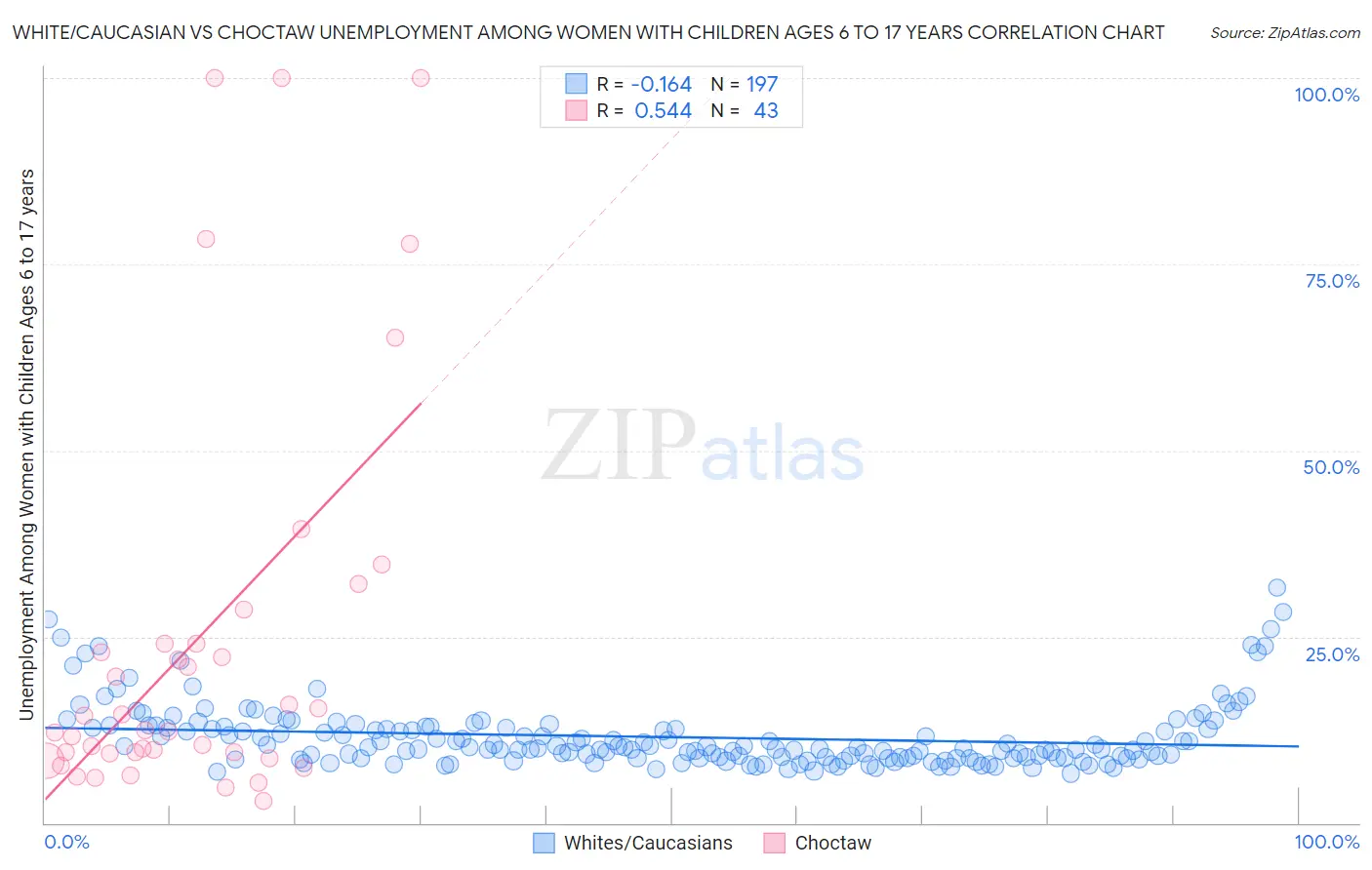White/Caucasian vs Choctaw Unemployment Among Women with Children Ages 6 to 17 years
COMPARE
White/Caucasian
Choctaw
Unemployment Among Women with Children Ages 6 to 17 years
Unemployment Among Women with Children Ages 6 to 17 years Comparison
Whites/Caucasians
Choctaw
9.6%
UNEMPLOYMENT AMONG WOMEN WITH CHILDREN AGES 6 TO 17 YEARS
0.1/ 100
METRIC RATING
273rd/ 347
METRIC RANK
9.9%
UNEMPLOYMENT AMONG WOMEN WITH CHILDREN AGES 6 TO 17 YEARS
0.0/ 100
METRIC RATING
286th/ 347
METRIC RANK
White/Caucasian vs Choctaw Unemployment Among Women with Children Ages 6 to 17 years Correlation Chart
The statistical analysis conducted on geographies consisting of 361,345,973 people shows a poor negative correlation between the proportion of Whites/Caucasians and unemployment rate among women with children between the ages 6 and 17 in the United States with a correlation coefficient (R) of -0.164 and weighted average of 9.6%. Similarly, the statistical analysis conducted on geographies consisting of 208,938,346 people shows a substantial positive correlation between the proportion of Choctaw and unemployment rate among women with children between the ages 6 and 17 in the United States with a correlation coefficient (R) of 0.544 and weighted average of 9.9%, a difference of 3.0%.

Unemployment Among Women with Children Ages 6 to 17 years Correlation Summary
| Measurement | White/Caucasian | Choctaw |
| Minimum | 6.6% | 2.9% |
| Maximum | 31.5% | 100.0% |
| Range | 24.9% | 97.1% |
| Mean | 11.5% | 24.7% |
| Median | 10.1% | 12.5% |
| Interquartile 25% (IQ1) | 8.7% | 9.3% |
| Interquartile 75% (IQ3) | 12.8% | 24.1% |
| Interquartile Range (IQR) | 4.1% | 14.7% |
| Standard Deviation (Sample) | 4.3% | 27.1% |
| Standard Deviation (Population) | 4.3% | 26.8% |
Demographics Similar to Whites/Caucasians and Choctaw by Unemployment Among Women with Children Ages 6 to 17 years
In terms of unemployment among women with children ages 6 to 17 years, the demographic groups most similar to Whites/Caucasians are Kiowa (9.6%, a difference of 0.010%), Aleut (9.6%, a difference of 0.050%), Immigrants from Latin America (9.6%, a difference of 0.070%), Immigrants from Nicaragua (9.6%, a difference of 0.47%), and U.S. Virgin Islander (9.7%, a difference of 0.49%). Similarly, the demographic groups most similar to Choctaw are Sierra Leonean (9.9%, a difference of 0.050%), Hispanic or Latino (9.9%, a difference of 0.12%), Shoshone (10.0%, a difference of 0.29%), Yakama (9.9%, a difference of 0.43%), and Central American Indian (9.9%, a difference of 0.58%).
| Demographics | Rating | Rank | Unemployment Among Women with Children Ages 6 to 17 years |
| Blackfeet | 0.2 /100 | #269 | Tragic 9.6% |
| Immigrants | Nicaragua | 0.2 /100 | #270 | Tragic 9.6% |
| Immigrants | Latin America | 0.1 /100 | #271 | Tragic 9.6% |
| Kiowa | 0.1 /100 | #272 | Tragic 9.6% |
| Whites/Caucasians | 0.1 /100 | #273 | Tragic 9.6% |
| Aleuts | 0.1 /100 | #274 | Tragic 9.6% |
| U.S. Virgin Islanders | 0.1 /100 | #275 | Tragic 9.7% |
| Immigrants | Portugal | 0.1 /100 | #276 | Tragic 9.7% |
| British West Indians | 0.1 /100 | #277 | Tragic 9.7% |
| French | 0.1 /100 | #278 | Tragic 9.7% |
| Scotch-Irish | 0.1 /100 | #279 | Tragic 9.7% |
| Seminole | 0.1 /100 | #280 | Tragic 9.7% |
| Jamaicans | 0.0 /100 | #281 | Tragic 9.8% |
| Slovaks | 0.0 /100 | #282 | Tragic 9.8% |
| Central American Indians | 0.0 /100 | #283 | Tragic 9.9% |
| Yakama | 0.0 /100 | #284 | Tragic 9.9% |
| Hispanics or Latinos | 0.0 /100 | #285 | Tragic 9.9% |
| Choctaw | 0.0 /100 | #286 | Tragic 9.9% |
| Sierra Leoneans | 0.0 /100 | #287 | Tragic 9.9% |
| Shoshone | 0.0 /100 | #288 | Tragic 10.0% |
| Hondurans | 0.0 /100 | #289 | Tragic 10.0% |